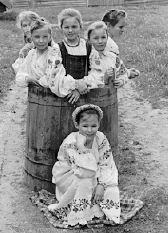| Belarus Table of Contents
In 1994 the annual population growth rate was estimated at 0.32 percent, resulting from a birth rate of 13.1 births per 1,000 population, a death rate of 11.2 deaths per 1,000 population, and a net migration rate of 1.3 persons per 1,000 population. The estimated 1994 average life expectancy at birth in Belarus was 66.2 years for males and 75.8 years for females. The annual population growth rate is expected to decrease slowly well into the next century as a result of fears of birth defects caused by Chornobyl' and the difficult economic situation. Population growth in Belarus has declined because of a rapid drop in fertility rates (an estimated 1.88 children per woman in 1994) and because of a sharp increase in infant and child mortality, which had been in decline before the Chornobyl' accident in 1986. Improvements in the infant mortality rate, which was estimated at 18.9 per 1,000 live births in 1994, were further blocked by poor maternal health, poor prenatal care, and frequent use of abortion as a means of birth control. Belarus has instituted a pronatal policy to counteract women's reluctance to have children, but difficult economic conditions and fear of birth defects caused by environmental pollution continue to be major causes of the decline in the birthrate. Falling birthrates have also contributed to the graying of the population. This will affect the country in a number of ways, including the allocation of funds from its budget. With fewer workers supporting more pensioners, the administration will be paying more in pensions than it collects in taxes. The population's sex structure was most profoundly affected by World War II. The large loss of male lives during the war ensured not only that there would be a surplus of women, but that this surplus would persist for at least another generation. A law passed in September 1992 gave the entire population of Belarus an automatic right to citizenship. This included all the ethnic Russians who had moved there over the years, not the least of whom were military personnel, officials, and policy makers. However, many declined to acquire Belarusian citizenship, so that Belarus was sometimes represented or administered by ethnic Russians who are residents, but not citizens of Belarus, as, for example, by its diplomats abroad. In 1992 Belarus's largest cities were Minsk, the capital, with 1.7 million inhabitants; Homyel', with 517,000; Vitsyebsk, with 373,000; Mahilyow, with 364,000; Hrodna, with 291,000; and Brest, with 284,000. The republic included more than 100 cities and towns, twelve of which had a population of 100,000 or more. Of the total population, 68 percent lived in cities and 32 percent lived in rural areas in 1994. These figures resemble those for the former Soviet Union as a whole. For more recent population estimates, see Facts about Belarus. 
Custom Search
Source: U.S. Library of Congress |
 In July 1994, an estimated 10,404,862 people (fifty persons per
square kilometer) lived in Belarus, with additional populations of
ethnic Belarusians living in Poland, Russia, Ukraine, Kazakhstan,
Latvia, Lithuania, and Estonia. Ethnic Belarusians in the West (living
primarily in Britain, Germany, France, Belgium, the United States,
Canada, and Argentina) numbered more than 1 million.
In July 1994, an estimated 10,404,862 people (fifty persons per
square kilometer) lived in Belarus, with additional populations of
ethnic Belarusians living in Poland, Russia, Ukraine, Kazakhstan,
Latvia, Lithuania, and Estonia. Ethnic Belarusians in the West (living
primarily in Britain, Germany, France, Belgium, the United States,
Canada, and Argentina) numbered more than 1 million.